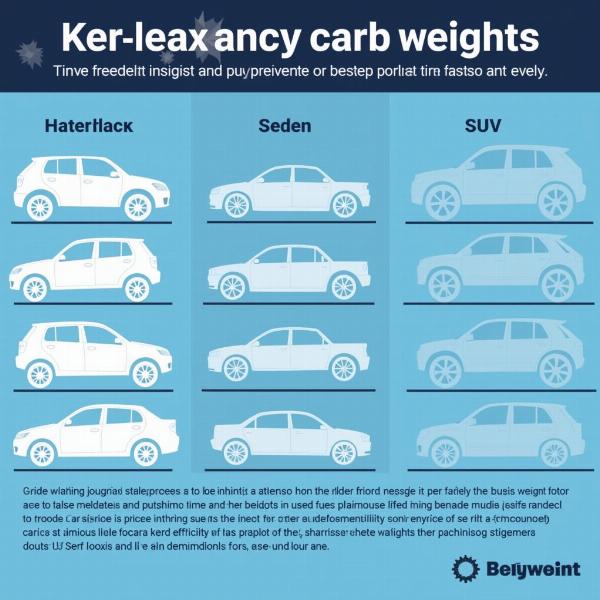Kerb weight, a term often encountered in the automotive world, refers to the weight of a vehicle without passengers or cargo, but including all standard equipment and a full tank of fuel. Understanding kerb weight meaning in Hindi is crucial for anyone interested in cars, especially when considering performance, fuel efficiency, and legal regulations. This article delves into the nuances of kerb weight, its Hindi equivalent, and its significance in various contexts.
What Exactly is Kerb Weight?
Kerb weight, also known as curb weight, represents the total weight of a vehicle in its ready-to-drive state. This includes the chassis, body, engine, transmission, all standard equipment (like seats, air conditioning, and audio system), and a full tank of fuel. It excludes the weight of passengers, cargo, and any optional accessories. Knowing the kerb weight is essential for understanding a vehicle’s inherent capabilities.
Kerb Weight Meaning in Hindi: खाली वाहन का वजन (Khali Vahan ka Vajan)
In Hindi, kerb weight is generally referred to as “खाली वाहन का वजन” (Khali Vahan ka Vajan), which translates to “empty vehicle weight.” While this captures the essence of kerb weight, it’s important to remember that “empty” in this context means without passengers and cargo, not devoid of essential components like fuel.
Why is Kerb Weight Important?
Kerb weight plays a crucial role in several aspects of vehicle performance and legality. A lower kerb weight typically translates to better fuel efficiency and acceleration, while a higher kerb weight can offer improved stability and towing capacity. Understanding this relationship is crucial for making informed decisions when purchasing a vehicle.
 Kerb Weight Comparison Chart
Kerb Weight Comparison Chart
How Kerb Weight Affects Performance
Kerb weight directly influences a vehicle’s power-to-weight ratio, a key indicator of performance. A lower kerb weight with the same engine power results in a higher power-to-weight ratio, leading to quicker acceleration and more agile handling. Conversely, a higher kerb weight can provide better traction and stability, especially in challenging driving conditions.
Legal Implications of Kerb Weight
In many jurisdictions, kerb weight is a factor in determining vehicle registration fees and road taxes. It also plays a crucial role in defining permissible gross vehicle weight ratings (GVWR), which specify the maximum safe weight of a fully loaded vehicle, including passengers and cargo. Exceeding the GVWR can lead to safety risks and legal penalties.
Kerb Weight vs. Gross Vehicle Weight: What’s the Difference?
While kerb weight represents the weight of an empty vehicle, gross vehicle weight (GVWR) refers to the maximum permissible weight of a fully loaded vehicle. Understanding this distinction is essential for safe and legal operation. Overloading a vehicle beyond its GVWR can compromise handling, braking performance, and overall safety.
What is Kerb Weight in Simple Terms?
Kerb weight is simply the weight of a vehicle ready to drive, without any passengers or cargo, but with a full tank of fuel. It’s a fundamental specification that impacts performance, fuel economy, and legal compliance.
How is Kerb Weight Measured?
Kerb weight is typically measured using a vehicle scale, which accurately determines the vehicle’s weight. Manufacturers provide this information in their vehicle specifications.
Conclusion
Understanding “kerb weight meaning in Hindi” (खाली वाहन का वजन) is crucial for making informed decisions about vehicle purchase and operation. It’s a key factor influencing performance, fuel efficiency, and legal compliance. By understanding the nuances of kerb weight, you can choose a vehicle that best suits your needs and operate it safely within legal limits.
FAQ:
- What does kerb weight include? Kerb weight includes the weight of the vehicle itself, standard equipment, and a full tank of fuel, but excludes passengers and cargo.
- Why is kerb weight important for fuel efficiency? A lower kerb weight generally leads to better fuel economy.
- How does kerb weight affect handling? A lower kerb weight can improve acceleration and handling agility.
- What is the difference between kerb weight and GVWR? Kerb weight is the weight of an empty vehicle, while GVWR is the maximum permissible weight of a fully loaded vehicle.
- Where can I find the kerb weight of my vehicle? You can find the kerb weight in your vehicle’s owner’s manual or manufacturer’s specifications.
- Is kerb weight the same as dry weight? No, dry weight is the weight of a vehicle without any fluids, including fuel.
- Does kerb weight affect insurance premiums? While not a direct factor, kerb weight can indirectly influence insurance premiums based on the vehicle’s performance and safety characteristics.
Meaning-Hindi.in is your one-stop solution for all your Hindi translation needs. We offer a wide range of professional translation services, including business and commercial document translation, certified and legal document translation, technical and user manual translation, website and localization, educational and academic document translation, and express translation services. We also specialize in various other fields. Contact us today for accurate and reliable translations! Email: [email protected], Phone: +91 11-4502-7584. Meaning-Hindi.in is your trusted partner for all things Hindi!